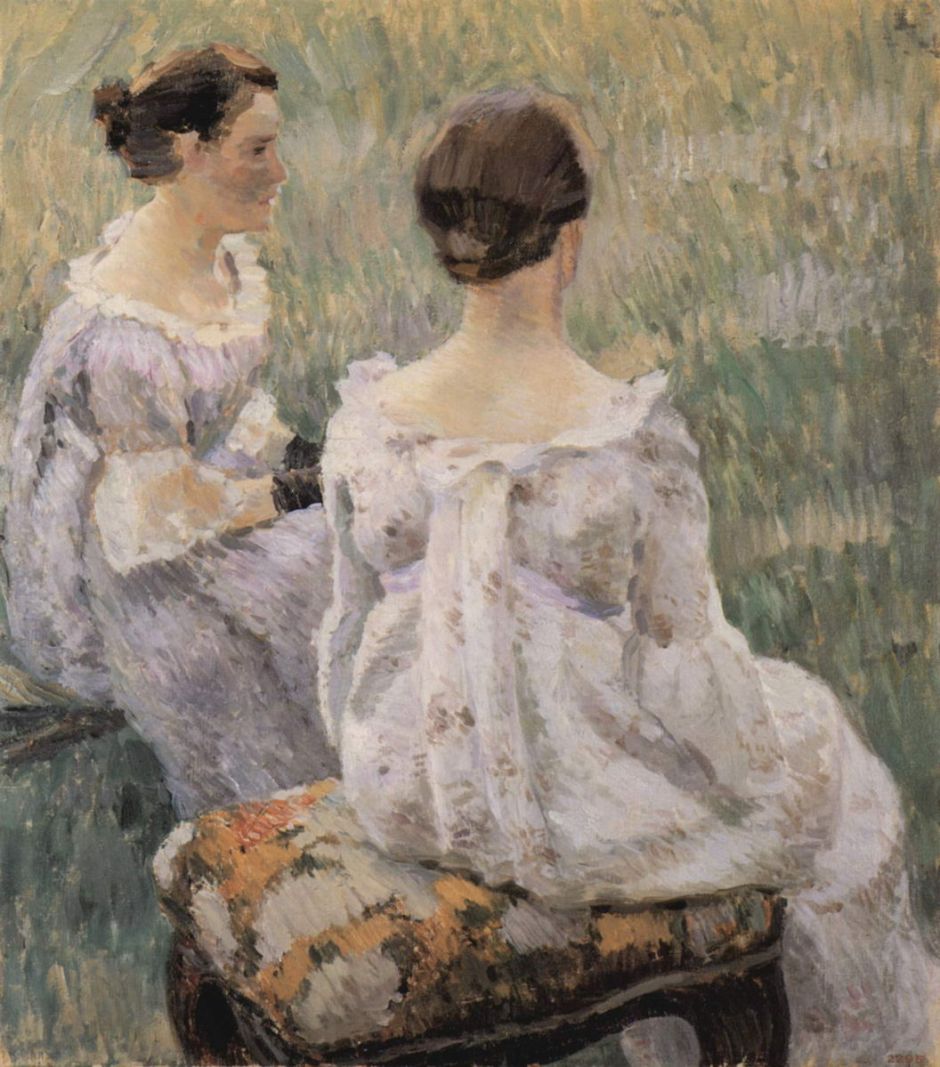Among the Russian painters associated with Mikhail Vrubel and Symbolism in the early twentieth century is Victor Borisov-Musatov (1870–1905). Described on Wikipedia as mixing “Symbolism, pure decorative style and realism”, I hope that you enjoy this small selection of his paintings as much as I do.
Born Victor Elpidiforovich Musatov in 1870 in Saratov, a city on the Volga River upstream of Volgograd, his family had humble origins. At the age of 14 he entered the local ‘real school’, where his artistic talent was spotted. From there he went to study in the Moscow School of Painting, Sculpture and Architecture at the age of 20, and the following year to the Imperial Academy of Arts in Saint Petersburg, the pinnacle of teaching at the time in Russia. Unfortunately, he didn’t cope with the climate there, and at the age of 23 returned to Moscow to complete his training in 1895.

Musatov painted May Flowers in 1894, when he was still a student in Moscow. Two girls are playing ball in the middle of a Spring day, in full sunshine, amidst the rich white blossom on surrounding shrubs and trees.

At some stage in 1895, Musatov appears to have visited the Caucasus Mountains, where he painted this plein air oil sketch, A Caucasian Study.
He then went to study under Fernand Cormon in Paris for three years. He apparently fell under the influence of Pierre Puvis de Chavannes and the Impressionists, including Berthe Morisot, who died in March 1895.

At this time, Musatov developed a fascination with the form of the agave, tropical plants which had been introduced to Europe from the Americas in the sixteenth century. Girl with Agave from 1897 shows one such plant in a terracotta pot, painted with exuberant brushstrokes.
After three years in Paris, he returned to Russia, and started painting scenes featuring affluent ladies in imaginary country estates, based on the country seat of contemporary Russian princes.

Musatov also switched to painting in a combination of oils and tempera, as in this Self-portrait with Sister from 1898, which shows his sister Yelena together with another agave plant, this time in a wooden tub on a stone pedestal. She is very elegantly dressed, and holds a folded fan on her lap.

He painted portraits following his return from France, and figurative works such as this study of Two Women Sitting from 1899.

As well as painting in oils and tempera, he used pastels, as seen in A Romance from 1900. There’s an indecipherable dedication at the bottom left, suggesting that he painted this for the woman who appears to be playing a xylophone or similar musical instrument. This could be his fiancée Yelena Alexandrova.

In addition to his figurative paintings set in country estates, Musatov painted at least one classical narrative work, of Daphnis and Chloe in 1901. The couple are the leads in an ancient Greek novel from the second century CE. They are each abandoned at birth, then brought up together, herding flocks for their foster parents. Musatov shows them walking naked in front of a black goat and their flock of sheep, Daphnis playing the ‘Pan’ pipes.

The Pool (1902) is one of his major paintings, executed in tempera, and shows two women in one of his imaginary country estates. The models were his sister Yelena Musatova and his fiancée, the artist Yelena Alexandrova, whom he later married.

Some of his fictional estate paintings explored darker themes. Phantoms, from 1903, shows the ghosts of young women drifting serenely in front of the steps of a grand country house. This work was popular with some of the major Russian Symbolist authors of the time.

The Emerald Necklace (1903-04) continues the series. The necklace of the title is presumably that worn by the woman in the light gown at the left, who is staring into the distance. This looks as if it refers to a literary narrative, but I’ve been unable to discover one.
In 1904, Musatov had a successful solo exhibition in Germany, and the following year he exhibited at the Salon in Paris.

Autumn Song from 1905 is a dazzling pastel painting of the rich colours of the start of autumn.

I have one undated pastel painting, titled Loneliness, which shows a woman alone against a balustrade under the light of the moon.
Musatov died of a heart attack in the autumn of 1905, at the age of just 35.
His paintings are a delight, and some do explore the unearthly. But do they meet any of the commonly accepted criteria for being Symbolist? I remain unconvinced.
Reference

